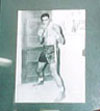Home | Cultural Lifeways | Leisure and Recreation | Boxing and Rodeo
Boxing and Rodeo
Boxing
 Blacks in Alberta excelled in a variety of
sports, including baseball, track and field,
football, and boxing. Boxing, or pugilism as it was called in the 19th
and early 20th centuries, was primarily a working-class activity because it
appealed mainly to society’s economic underclasses—including
Blacks. Prior to 1950, Alberta’s best-known Black athletes were primarily
boxers, reflecting their direct association with Alberta’s working-class
culture. Upper-class society was completely disinterested in the sport: many
viewed it as deviant and marred with grotesque violence. Early 20th-century
boxing often implicated such issues as class and ethnicity; one can therefore
begin to understand the direct connection between the sport of boxing and Black
athletes in Alberta.
Blacks in Alberta excelled in a variety of
sports, including baseball, track and field,
football, and boxing. Boxing, or pugilism as it was called in the 19th
and early 20th centuries, was primarily a working-class activity because it
appealed mainly to society’s economic underclasses—including
Blacks. Prior to 1950, Alberta’s best-known Black athletes were primarily
boxers, reflecting their direct association with Alberta’s working-class
culture. Upper-class society was completely disinterested in the sport: many
viewed it as deviant and marred with grotesque violence. Early 20th-century
boxing often implicated such issues as class and ethnicity; one can therefore
begin to understand the direct connection between the sport of boxing and Black
athletes in Alberta.
One of Alberta’s most prominent and successful boxers was Joe “Dad” Cotton. Born into salvery on 26 February 1853, Cotton later moved to the American West Coast and became a heavyweight prizefighter. When Cotton was 46—arguably at the peak of his career—he continued to scrap with opponents in California: some matches would last close to 30 rounds and several hours. Cotton was a well-respected boxer throughout North America and once served as a sparring partner for Jack Johnson, the first Black heavyweight champion of the world.
 Having moved to Edmonton in 1912, Cotton soon
opened a local boxing club where he trained, coached, and developed young
boxers and even refereed bouts. He was instrumental in actively promoting the
sport of boxing in Edmonton until his death in 1949 at the age of 96. A true
physical specimen, Cotton fought his last match at the remarkable age of 61,
sending his opponent to the canvas and winning in a knockout. He was also an
active member of his local church and founded an all-Black lodge in Edmonton.
Having moved to Edmonton in 1912, Cotton soon
opened a local boxing club where he trained, coached, and developed young
boxers and even refereed bouts. He was instrumental in actively promoting the
sport of boxing in Edmonton until his death in 1949 at the age of 96. A true
physical specimen, Cotton fought his last match at the remarkable age of 61,
sending his opponent to the canvas and winning in a knockout. He was also an
active member of his local church and founded an all-Black lodge in Edmonton.
Other boxers soon followed in Cotton’s footsteps. Brothers Richard and Nathaniel Lipscombe participated in boxing matches during the 1920s. Harvey Bailey, also known as “Flash” Bailey because of his lightning-quick speed, won the Western Canadian featherweight championship in 1935. Another Edmontonian, Benny Geary, won the Western Canadian welterweight championship, while Vern Escoe held the Canadian heavyweight championship in the 1940s. Doug Harper of Amber Valley was Canada’s light-heavyweight champion in the early 1950s.
Rodeo
John Ware was the creator of the modern rodeo. A pioneering rancher working in southern and central Alberta, Ware gained considerable respect among the locals for his impressive ability to ride unbroken horses. Ware boasted to friends and family that he had “the distinction of never having been thrown from a horse.” He garnered even more praise when he “accidentally” invented steer wrestling, a central feature of any modern rodeo event.
In 1892, when confronted by a charging steer, Ware instinctively reached for its horns and wrapped his other arm around the steer's head, which he twisted, eventually wrestling the steer to the ground. Later that year, Ware demonstrated this new technique at an equestrian show in Calgary, and the crowd was instantaneously mesmerized by his sheer power and ability. At the Calgary Fair the next year, Ware dominated a steer roping and tying contest. Shortly thereafter, events such as these began to replace exhibition events and the modern competitive rodeo was born.
Of interest, the term “rodeo” is derived from the Spanish verbrodear meaning “to surround or round-up.” The term rodeo, however, was not used until the mid-1910s. Prior to this, events such as the one created by John Ware were featured in what was commonly referred to as “cowboy competitions.”
Editor's Note:
More information on John Ware is available through the Glenbow Museum's Web site, Mavericks: An Incorrigible History of Alberta. Simply follow the link to Ranching which appears in the top right corner of the Web site's graphical interface, then follow the link from the photo of John Ware (second from the left in the top row). Please note that you will require Flash Player to view the Mavericks: An Incorrigible History of Alberta Web site.




